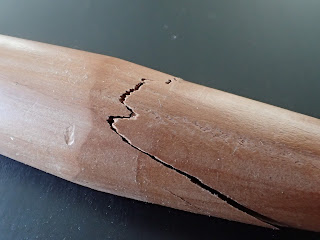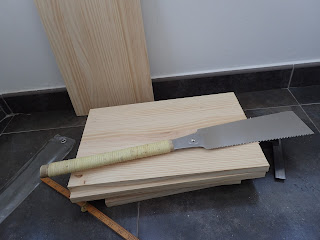This chair didn't get used a whole lot, until I brought it with us to Spain. We have a furnished apartment here, but it was a simple thing to bring this chair along since it folds up into a neat bundle. I find myself using this chair multiple times per day here, as it is the perfect thing for watching TV in our new apartment here.
That is, it was the perfect thing. A few days ago there was a bit of a mishap:
 |
| OK, this is a bit of an exaggeration. This was after I removed the offending stretcher. |
The chair was not as stiff as it had been, and upon inspection, I found the following break in the stretcher on the left side of the chair that goes from front to back. It was on the rear side of the chair.
 |
| Ouch! |
 |
| Is it really that bad? |
 |
| Yes. Yes it is really that bad. |
This was the first Roorkee chair I ever made, and I turned the stretchers on a lathe. This chair got me into a bad habit, though. I must confess that I always make this tapered tenon 100% with the tapered tenon cutter from Lee Valley.
The recommended way to make this tenon is to turn the rough shape of it on the lathe, and then finish with just a few turns of the tapered tenon cutter for a finished shape. This method preserves the shape of the tenon being perfectly centered on the dowel.
What I did was turn the dowel on the lathe, put it in a vice and use the tenon cutter like a pencil sharpener to make the tapered tenon from the beginning.
I determined that this really wasn't all that difficult, and since then I've made all my tapered tenons this way.
The big problem, is that it is easy for the tenon cutter to get off a bit. This particular tapered tenon looked like it was bent. What must have happened, is I must have put a bit more pressure on one side of the tenon cutter than the other while turning it, resulting in the center of the tenon not being centered on the center of the dowel.
Long story short, when I put this chair back together, this "bent" tenon was in the back on the side, a position which I have discovered is the highest stress part of the whole chair.
The best fix for this is to turn a new stretcher, corectly taper the tenon and replace.
Unfortunately, I don't think I have enough pear left to make another stretcher like this. If I do, it is in Munich, and not here in Spain with me. For the meantime, I can either try to repair it, or turn a new dowel in a completely new species of wood.
For starters, I think I'll just try to glue it back together and see if that works. I first thought of liquid hide glue, since it's reversible. On the other hand, if it doesn't work the first time, what's the point? Plus, liquid hide glue won't do squat on the crack that runs perpendicular to the grain. Pretty much no glue would.
What I think I'll try is super glue.
 |
| How super is Super Glue? |
 |
| Glue applied. |
The idea was that the tapered mortise would press everything into the shape it needed to be in.
The other thing I did was every few seconds I rotated the dowel, so it did not get glued and stuck to the mortise permanently.
Here's what I wound up with:
 |
| Glue is set. |
 |
| The good news is it seems to be working. |
The fix seems to be holding. I've been sitting in it for a couple of days, and there were no problems until the other night. I was leaning sideways in the chair, and I heard a snap.
To my chagrin, I could see space in the crack across the grain, but the long grain part of the crack was still holding.
 |
| The crack. |
 |
| A bit of a closer view. |
I have a couple of options:
- I could just glue it again
- saw it apart, and glue it up again with a floating tenon or a dowel. I think this is how I would fix an antique piece. Since this tenon is "bent," I'm not sure it's worth it. Although, I could scrap the current tenon, attach a new piece of wood and re-shape the tenon with the tenon cutter.
- I could make a new stretcher - although I am pretty sure I do not have enough pear so it might be a contrasting species.
- I am kind of leaning toward scrapping all of the wood for this chair and building a new one, recycling the leather from this chair.
Create your own user feedback survey












